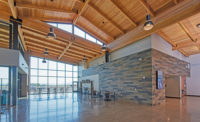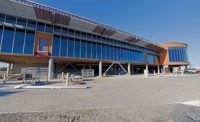Elmira-Corning Regional Airport (ELM) Terminal Revitalization
Elmira, N.Y.
Best Project
Owner: County of Chemung
Lead Design Firm, Civil/Structural/MEP Engineer: McFarland-Johnson Inc.
General Contractor: Welliver
Architect: Fennick McCredie Architecture Ltd.
A $60-million expansion and modernization effort has transformed the Elmira-Corning Regional Airport terminal from an outdated, crowded facility where airlines couldn’t grow their operations into a state-of-the-art hub—all without disrupting regular operations.
The 19-month project solved many problems for an aging facility that was getting increasing use but didn’t have the capacity to handle larger aircraft, leading to more instances of ground boarding and creating travel delays. The challenge was maintaining passenger service and meeting a tight timeline required by grant funding. “It’s impressive what they did using state grant money,” one judge said.
The team aimed for as few phases as possible, using temporary facilities to keep services in place while it demolished areas such as the restaurant, baggage claim and main terminal spaces. It then built out space for the new baggage area, a TSA checkpoint and other services, thereby allowing gutting and renovation to proceed in the other half of the terminal. Nearly every part of the airport received upgrades, which included a new restaurant and bar, navigational signage and exterior improvements for the control tower.
The design also improved the overall look of the facility, in part to meet state grant funding requirements for a “wow factor.” There is now extensive glass throughout—including at ticketing, baggage claim and departure lounges—as well as courtyards with local plants, boarding bridges connecting to all aircraft, a winding path with curved glass walls for the TSA wait line, terrazzo panels and bluestone finishes, and full height glass airfield walls. One large courtyard lets passengers use outdoor walking paths in the departure area.
The new facility also has upgraded utilities and greater energy efficiency, including a ground-source heat pump system with 78 geothermal wells drilled 450 ft into the ground.
The project had a lost time accident rate of zero and an OSHA recordable incident rate of zero—thanks to a safety program that covered 200,000 worker hours on the project.
Back to "Airports, Culture Projects Dominate Region’s Awards"








Post a comment to this article
Report Abusive Comment